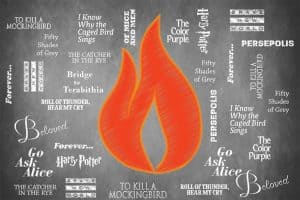
First published in 1974, the American Library Association’s (ALA) Intellectual Freedom Manual has become an essential reference for library workers who need dependable answers to thorny questions about book challenges, patron privacy, and policy development for their institutions. The 10th edition, coedited by Martin Garnar, director of Amherst (Mass.) College Library and former president of the Freedom to Read Foundation (FTRF), and Trina Magi, library professor and reference and instruction librarian at University of Vermont, was released under the direction of ALA’s Office for Intellectual Freedom (OIF) earlier this year. American Libraries spoke with Garnar and Magi, as well as several of the manual’s contributors, about the latest challenges to intellectual freedom that library workers face. Helen R. Adams is a retired Wisconsin school librarian and online instructor in intellectual freedom, privacy, and copyright; Deborah Caldwell-Stone is director of OIF and executive director of FTRF; and Theresa Chmara is general counsel of FTRF.
What were some of the biggest changes in the manual—such as new laws, policy updates, privacy rules, and technology issue—since the ninth edition in 2015?
 MARTIN GARNAR: One of the biggest changes was the sheer number of new interpretations of the Library Bill of Rights—eight in total, with topics ranging from religion and politics to internet filtering and equity, diversity, and inclusion. These interpretations reflect the ever-evolving understanding of how our professional principles and values should be applied in our daily library work. We also saw the first revision of the Library Bill of Rights since 1980 with the addition of an article on privacy in 2019. The expiration of parts of the USA Patriot Act in 2020 meant that the authors of our legal essays had to make significant revisions to their contributions to the manual.
MARTIN GARNAR: One of the biggest changes was the sheer number of new interpretations of the Library Bill of Rights—eight in total, with topics ranging from religion and politics to internet filtering and equity, diversity, and inclusion. These interpretations reflect the ever-evolving understanding of how our professional principles and values should be applied in our daily library work. We also saw the first revision of the Library Bill of Rights since 1980 with the addition of an article on privacy in 2019. The expiration of parts of the USA Patriot Act in 2020 meant that the authors of our legal essays had to make significant revisions to their contributions to the manual.
 TRINA MAGI: The new edition includes information about self-service hold practices, new guidelines on when to call the police, expanded content about developing library policies that support intellectual freedom, and a significantly expanded glossary of terms. The essay on the law regarding privacy and confidentiality in libraries was updated to include information about the European Union’s General Data Protection Regulation and information about threats to privacy from third-party vendors.
TRINA MAGI: The new edition includes information about self-service hold practices, new guidelines on when to call the police, expanded content about developing library policies that support intellectual freedom, and a significantly expanded glossary of terms. The essay on the law regarding privacy and confidentiality in libraries was updated to include information about the European Union’s General Data Protection Regulation and information about threats to privacy from third-party vendors.
 THERESA CHMARA: From a legal perspective, the Deeper Look entries that focus on the law provide updated information about how courts have dealt with those particular issues. For example, the ninth edition offered legal information about meeting rooms that was expanded in this edition to provide case law information about social media. The Deeper Look section explores how courts have addressed cases where government entities subject to First Amendment strictures, like public libraries, removed posts or blocked speakers.
THERESA CHMARA: From a legal perspective, the Deeper Look entries that focus on the law provide updated information about how courts have dealt with those particular issues. For example, the ninth edition offered legal information about meeting rooms that was expanded in this edition to provide case law information about social media. The Deeper Look section explores how courts have addressed cases where government entities subject to First Amendment strictures, like public libraries, removed posts or blocked speakers.
 HELEN R. ADAMS: The essay “Censorship beyond Books” is significant. It acknowledges that there are more types of censorship occurring than that of books. Censorship attempts are made against digital databases, programs (author programs in schools are a prime example, as are drag queen programs), displays (including student artwork or LGBTQ material displays), and library bibliographies or reading lists.
HELEN R. ADAMS: The essay “Censorship beyond Books” is significant. It acknowledges that there are more types of censorship occurring than that of books. Censorship attempts are made against digital databases, programs (author programs in schools are a prime example, as are drag queen programs), displays (including student artwork or LGBTQ material displays), and library bibliographies or reading lists.
How did you solicit input or feedback from library workers in writing your sections? What new issues were they dealing with on the ground that they needed guidance on?
MAGI: During the years between the publication of the prior edition and the preparation of the manuscript for the 10th, I made lots of little notes about content that should be added or changed. Over time, my copy of the 2015 edition became full of yellow Post-it notes reminding me of ideas for new or revised content. These ideas came from my reading of library literature, from my own use of the manual, and from questions that library workers asked when they called for help about intellectual freedom concerns.
CHMARA: As general counsel for FTRF, I interact with librarians often during the course of my legal representation. I am also a frequent speaker to library groups. Additionally, I recently taught an ALA e-course that addressed legal issues confronting libraries and received feedback from librarians about the types of legal issues they have to address.
ADAMS: In July 2019 I conducted an informal survey for purposes of updating my essay “Internet Filtering and School Libraries” and received responses from librarians in 41 states. Although restrictive filtering still occurs in many schools, in 2019 there was a more nuanced view of filtering by school librarians. Whatever one’s opinion of internet filtering in schools, students have legitimate information needs. The latest edition of the manual offers school librarians multiple strategies to lessen the negative impact of filters.
The 10th edition includes a section on law enforcement and libraries, including guidelines on when library workers should call the police. Does the manual offer any new guidance on policing and libraries from a racial justice perspective?
MAGI: The section “Visits and Requests from Law Enforcement” is not new, but the guidelines on when library workers should call the police are a new addition to that chapter. At the end of those guidelines is a highlighted box referring readers of the manual to an important American Libraries article by Jarrett Dapier and Emily Knox, “When Not to Call the Cops” (The Scoop, July 8, 2020).
This year marks the 20th anniversary of the Patriot Act. Can you talk about how that law has affected libraries over the past two decades and what the future might hold?
CHMARA: Over the last 20 years, libraries have had to draft policies on how to address Patriot Act requests and other requests from law enforcement. Additionally, they have had to address how they collect information, how long they retain personally identifiable information about patrons, and how to respond to other third-party requests for information. Libraries also have had to expand training of library staff and volunteers to address privacy and confidentiality issues.
 DEBORAH CALDWELL-STONE: We faced a dilemma regarding the extensive information we included on Section 215 of the act, which authorized mass surveillance and data gathering of citizens by the government. Congress had allowed Section 215 to sunset through inaction, but we could not predict if, during the waning months of the prior administration, they would renew it. We added a text box to alert readers to the status of Section 215 and recommend that they check with OIF or their legal counsel on the status of the law.
DEBORAH CALDWELL-STONE: We faced a dilemma regarding the extensive information we included on Section 215 of the act, which authorized mass surveillance and data gathering of citizens by the government. Congress had allowed Section 215 to sunset through inaction, but we could not predict if, during the waning months of the prior administration, they would renew it. We added a text box to alert readers to the status of Section 215 and recommend that they check with OIF or their legal counsel on the status of the law.
While some of the specific threats posed by the act have receded with the sunsetting of Section 215, other provisions remain in effect, and libraries must be prepared to defend against law enforcement agencies’ efforts to gain access to user records.
[Library workers] can assign readings in the manual as a way to orient new employees, volunteers, and trustees or as part of the library’s professional development program. —Trina Magi, coeditor of the Intellectual Freedom Manual
GARNAR: The Patriot Act has had a profound impact on how libraries and library workers view their role as privacy protectors and educators. I was just a few years out of library school when the law was passed, and I spent so much of my time giving presentations about its dangers and what libraries could do to protect user privacy. It was a formative part of my identity as a librarian. I believe that libraries are still regarded as one of the few places that care about privacy because of our efforts around the Patriot Act, though it is a never-ending task to stay on top of all the ways our privacy can be breached or compromised.
As for the future, it will be interesting to see if Congress takes action to reauthorize Section 215. I hope they honor the spirit of the sunset provision, which was that it should have been a temporary measure in the wake of 9/11 and not a permanent change to our expectations around privacy.
What are some of the practical ways library workers can use the information in the manual in their work, as opposed to just reading it once or keeping it on a shelf?
GARNAR: In Part I, there are checklists—with actual check boxes—to guide library workers through the policy creation and revision process. The Issue at a Glance sections at the start of each chapter in Part II include discussion questions designed to be used for professional development. Part III contains information about what to do in a crisis and whom to contact for help or advice.
MAGI: When a question or need arises, library workers can quickly turn to the relevant chapter and get a summary of key points, official ALA policy statements about the issue, and more in-depth essays about the library’s legal obligations. And they can assign readings in the manual as a way to orient new employees, volunteers, and trustees or as part of the library’s professional development program.
CHMARA: While the manual does not constitute legal advice, it does provide legal information for librarians and their legal counsel that can be used as a starting point when drafting new policies, analyzing current policies, and addressing issues that arise at the library.
ADAMS: School librarians face many intellectual freedom issues, including challenges to print and nonprint resources, author visits, and library displays. The manual can be a “first responder” resource for those situations. The essay “How to Respond to Challenges and Concerns about Library Resources” is a quick but practical read when immediate but thoughtful action is needed. The section also gives guidance to librarians on weighing their options when a reconsideration process is subverted or undermined. This is a resource to read repeatedly to be able to defend students’ right to read.
School librarians face multiple complex situations while protecting students’ library privacy. Many adults are not supportive of minors’ privacy, and laws protecting minors’ privacy are not particularly strong and are frequently ambiguous. Often librarians are left with Article VII of the Library Bill of Rights and Article III of the ALA Code of Ethics as defensive justification. While professional codes provide ethical support, they are not legal arguments. In chapter 7, Deborah Caldwell- Stone’s essay “The Law Regarding Privacy and Confidentiality in Libraries” can provide substantial information to educate and assist school library workers.
Libraries have had to deal with unprecedented challenges in the past year around COVID-19 and the sudden explosion of virtual programming, online learning, surveillance from test-taking platforms, and other issues. This book was already in production during 2020, but knowing what we now know about the pandemic’s effects on intellectual freedom issues, what do you wish could have been addressed?
CALDWELL-STONE: While the pandemic generated many challenges for libraries, the most immediate intellectual freedom challenges were related to access and privacy—for example, should libraries be in the business of contact tracing? What about mask wearing? Given the need for timely information, those specific topics were addressed through articles posted on our blogs and the ALA website but did not make the final text of the manual. Addressing disinformation, misinformation, and propaganda is another topic that might have made a valuable addition to the manual. We’ll certainly consider these topics for coverage in the next edition and work on developing online materials that are responsive to them.
GARNAR: The good news is that the committees work very hard to develop language and guidance that remains useful for some time after its adoption. Libraries supported online learning before the pandemic, so while the breadth of our concerns about privacy may have expanded, the core concerns haven’t changed. Likewise, the interpretation on library-initiated programs (last amended in June 2019) already acknowledges that our principles around programming are the same whether the program is being presented in the building, offsite with a partner, or online. Still, it would have been great to reference the resolutions adopted at Midwinter in 2021 about facial-recognition software and behavioral data surveillance. I would have loved to add notes at various points in the manual that emphasized “This is still true for online and remote services during the pandemic,” but I believe the guidance is still sound. I imagine the 11th edition will be careful to make this point, as I think libraries will continue to explore how the virtual and remote services developed during the pandemic can be part of our offerings going forward.
ADAMS: The topic of copyright was already within the manual, but school librarians are receiving more questions about fair use of online intellectual property. In chapter 5, the essay “The Law Regarding Copyright” by ALA’s Director of Public Policy and Advocacy Carrie Russell is useful, but having more in-depth information on fair use of resources in K–12 schools would be beneficial to librarians who act as copyright consultants to teachers and students.
CALDWELL-STONE: We need to acknowledge that the Intellectual Freedom Manual cannot cover every specific topic or issue that might arise. We can, however, strive to provide sufficient guidelines, checklists, and information that give library workers, administrators, and trustees the ability to apply the broad principles espoused in the Library Bill of Rights and the ALA Code of Ethics to new situations. I believe Martin and Trina have created a strong intellectual freedom toolbox that any person working in libraries can use to address any new challenge that arises in the course of providing library service.



